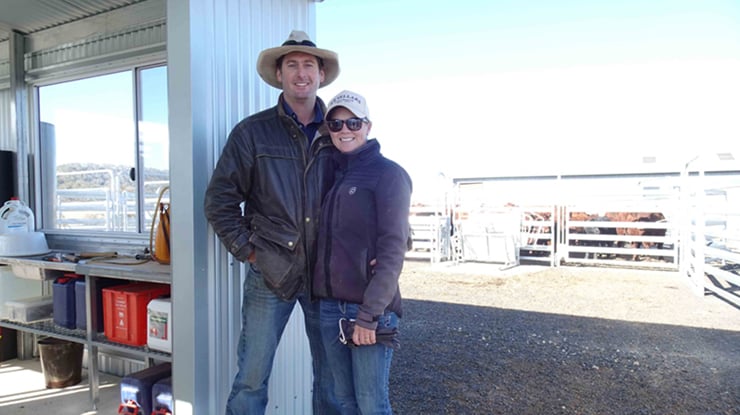Preparing your weaners for transport
18 September 2024
 Greg and Joanne Wright, Benoak Devon Stud, Glencoe NSW.
Greg and Joanne Wright, Benoak Devon Stud, Glencoe NSW.
For beef and wool producer Greg Wright, maintaining good relationships with carriers and preparing according to livestock type are important considerations for transport.
The fourth-generation grazier and his wife Joanne are the principals of ‘Oaklands’, ‘Claremont’ and ‘Benoak Devon Stud’, managed on 1,000ha across two properties in the Northern Tablelands, NSW.
Strong, well-handled weaners travel best
Greg said his weaner cattle are trucked between places once they are well-handled and settled – this can be anywhere from 10 days to three weeks after weaning.
“We make sure they’ve recovered well from the weaning process and are broken in and sensible,” Greg said.
“You want to know you can let them out onto new country and they’re going to go and eat, not just wander around looking for Mum.”
Weaners are handled to a point they accept the processes that take place in cattle yards, Greg explained.
“When we break the weaners in, we don’t overhandle them but set them up so they handle easily.
“They understand that if we’re standing next to a gate, we’re just counting them or assessing them, as a feedlot buyer would do when appraising stock.”
Any drafting is done at least the day before transport and animals are held in separate paddocks to avoid last minute stress or delays from unforeseen issues.
Stock are drafted into sizes as needed to ensure the smaller cattle aren’t impacted by bigger animals during transport, and the larger cattle can be loaded on the bottom pens.
“The day before trucking, we’ll bring them into holding yards or smaller paddocks,” Greg said.
“On the day of transport, we’ll have them settled in the yards and have everything done at least an hour before the truck is supposed to get there.
“Having them all done before the truck arrives, they just seem nice and settled. If something goes wrong, you’ve got time to sort it out.”
Mutual respect with professional transporters
The Wrights use Glen Innes-based StockTrans for their cattle transport and said they have a good relationship with the operators.
“If they give us a time, they try their hardest to stick to it.”
Having any associated paperwork filled out ready for drivers to add their details saves a lot of time, Greg added.
“We know they’ve got other jobs to do – they’ve got to be Cootamundra or wherever the same day – so we’re conscious of not holding them up.
“You want them happy to come back. You get to know each other and how each other works.
“Having truck drivers that are stock-orientated is excellent too. They always send good operators out. It seems to be a good relationship.”
Careful management of cows and calves
The Wrights try to avoid transporting cows and calves where possible due to the potential issues involved. However, if it must be done, Greg said careful management is key.
“If you’re trucking cows and calves, it means the season hasn’t gone your way. The only time we’ve ever done it is if the feed is cut out.
“You need to be careful. It can lead to mismothering, depending on the age of the calves.
“We would keep the cows and calves separate for the journey. When they arrive at the new destination you need a holding paddock to keep them in to make sure they’re all mothered up.”
Greg said it’s also important to think about things like rich feed and mastitis with cows. With the calves, he highlighted the importance of watching for stress and scours.
When transporting sheep and cattle, Greg said stock that have been on a truck when they’re younger can make life easier when they’re older – although he recognises this isn’t always possible.
“When stock are big, the problems compound. Stock that have been on trucks before load much better when they’re big, strong animals.”
Preparation prevents problems
The Wrights use different transporters to cart their sheep. They discuss numbers and type, length of journey and consider the transporter’s advice on preparation.
“With store lambs, we talk to the trucking company. If they say they’ve got a big trip and need to take them off water at least the night before, then that’s what I do. It seems to work okay.”
When transporting agistment cattle, it’s important to think about feed transition from where they’re coming from and going to, Greg advised.
“If stock are hungry and going onto rich clover like we’re seeing out west at the moment, you can pop them like a tub of popcorn.”
Planning the transition can save a lot of headaches and financial losses, Greg said.
“Make sure all their 5-in-1s are up to date and then have a plan when you get to the other place.
“Think about how you’ll tackle the feed transition. Maybe feed them hay, introduce to them to paddocks slowly and possibly green feed licks.”
For best practice guidelines on transporting livestock, visit MLA’s Transport Hub.


